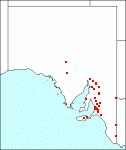Family: Poaceae
Danthonia caespitosa
Citation:
Gaudich., Voy. aut. Monde (Bot.) 408 (1829).
Synonymy: Notodanthonia caespitosa (Gaudich.)Zotov, New Zealand J. Bot. 1:117 (1963); D. semiannularis sensu J. Black, Fl. S. Aust. 107 (1943), partly, non (Labill.) R. Br.; Rytidosperma caespitosum (Gaudich.)Connor & Edgar, New Zealand J. Bot. 17:325 (1979).
Common name: White top, common wallaby-grass.
Description:
Very variable erect tufted perennial, 20-90 cm high; leaf sheaths rather densely hairy with tubercle-based hairs to 2 mm long or almost glabrous; ligule ciliate, the lateral hairs and those on the collar 3-4 mm long; leaves flat or loosely involute, 2-4 mm x c. 25 cm, glabrous or with hairs as on the abaxial surface of the sheath, adaxial surface with dense or sparse c. 1 mm long hairs.
Panicles shortly to much exserted, linear-lanceolate to lanceolate in outline, rarely ovate, usually with 10-30 spikelets; spikelets 4-9flowered, pale and usually shorter than the glumes; glumes 14-24 mm long, subequal, 5-7-nerved; lemma pale, 3-6 mm long including the 0.75-1.5 mm hairy callus, lanceolate, with 2 whorls of hairs on the back, the upper whorl 4-5 mm long, the lower whorl c. 2 mm long, often the most dorsal hair tufts absent from the lower whorl, glabrous or with scattered hairs between the whorls; lateral lobes with narrow membranous margins, flat portion c. 4 mm and fine awns c. 8 mm long, central awn 15-25 mm long, strongly exserted from the glumes, twisted 3-5 times in the lower part, exceeding the lateral lobes by 5-10 mm; palea usually exceeding the sinus by 0.5 to 2 mm, c. 3.5-5 mm long, often drawn out into a membranous tip, 2-fid, narrow-lanceolate, glabrous or pilose on the back; anthers 0.5-2 mm long, yellow, orange or white; grain oblanceolate, c. 2.5 mm.
Published illustration:
Cunningham et al. (1982) Plants of western New South Wales, p. 81.
|
|
Distribution:
|
Widespread in Australia except N.T. and Qld and in New Zealand. Very common in all the southern parts of S.Aust., but rare or absent in the 2 northern regions.
|
Conservation status:
native
Flowering time: almost always between Sept. — Dec.
|

SA Distribution Map based
on current data relating to
specimens held in the
State Herbarium of South Australia
|
Biology:
Vickery (1956) commented that despite exceptionally great variability it had not been found possible to segregate subspecific taxa. Specimens with reduced numbers of hairs in the tuffs below the sinus approach D. pilosa var. paleacea. Specimens with small lemmas seem to be very close to D. setacea Specimens without dorsal tufts above the callus approach D. laevis.
Author:
Not yet available
|

